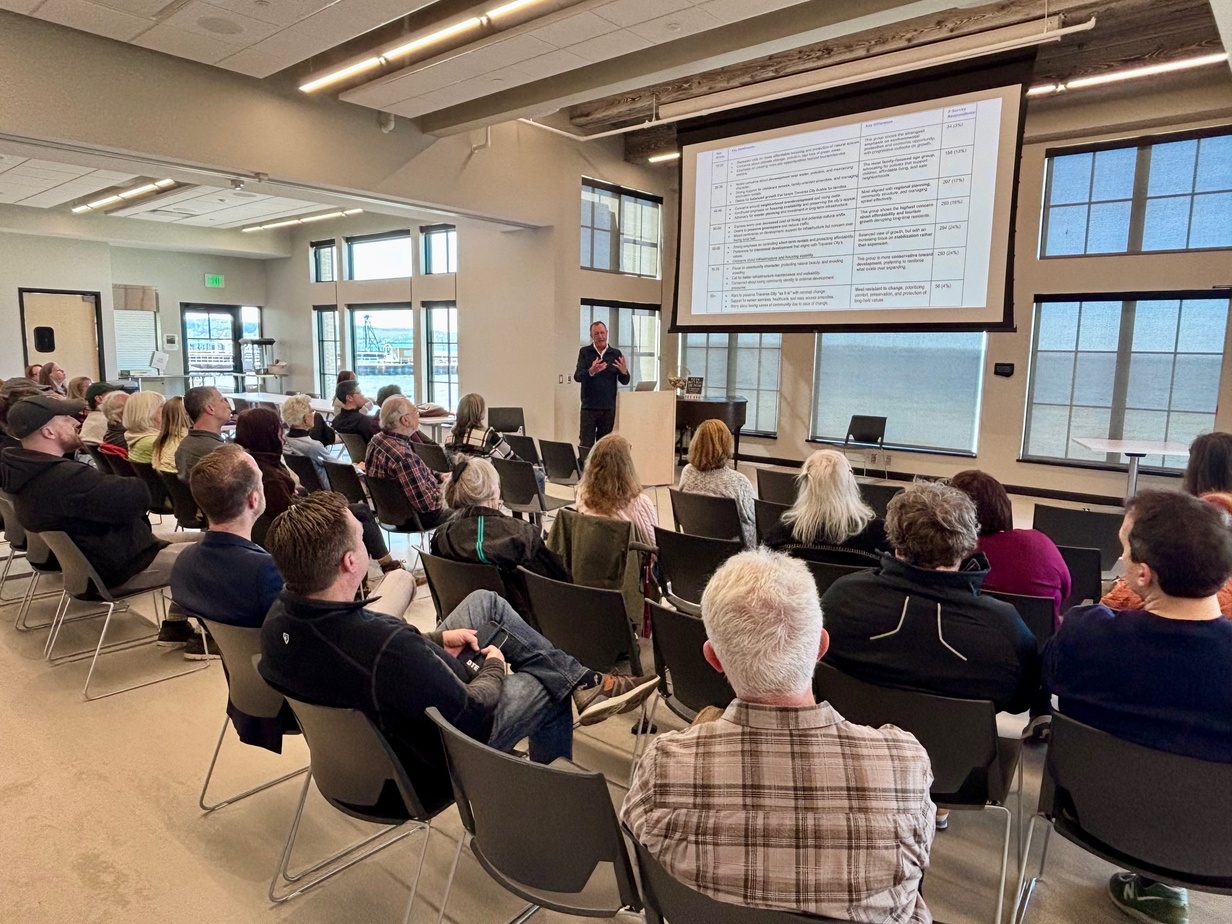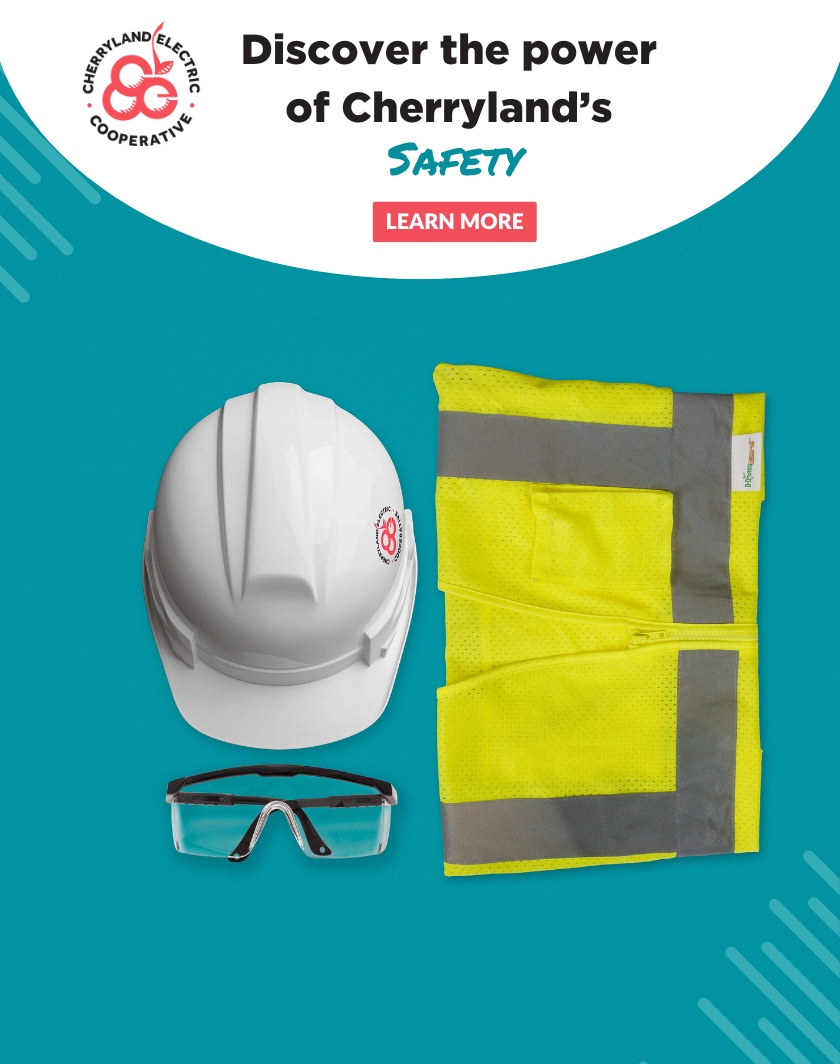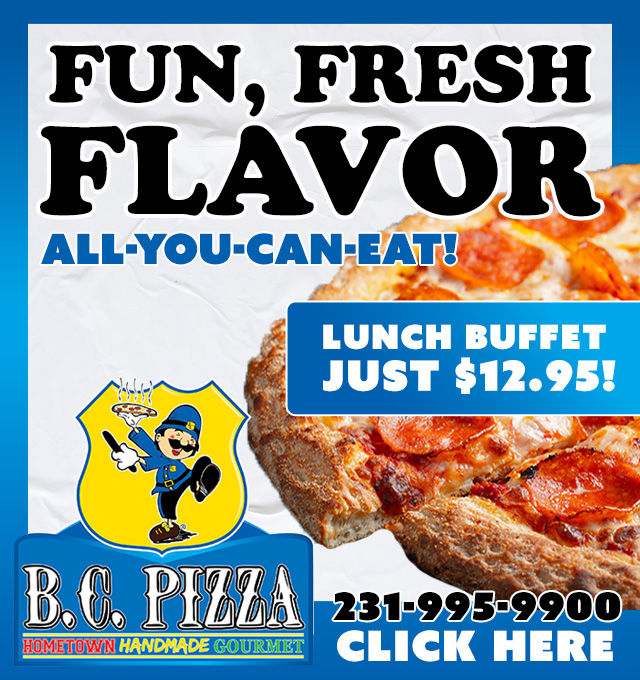
City Unveils Draft Strategic Action Plan
By Beth Milligan | May 21, 2025
After an extensive public engagement process that kicked off last fall, the City of Traverse City is preparing to adopt a new strategic action plan – a document that looks ahead through 2035 and provides recommendations for “addressing rapid change and envisioning how the city will thrive in the next decade,” according to City Manager Liz Vogel. Consulting firm Future iQ unveiled the draft plan to nearly 50 attendees at a community summit Monday at the Traverse City Senior Center, followed by a presentation to city commissioners. Commissioners are expected to formally vote to adopt the plan at their June 2 meeting.
The plan – created after multiple community surveys, think tanks, visioning sessions, stakeholder meetings, and focus groups – lists six strategic “pillars” or focus areas. Each of those areas supports a 2035 vision of an “equitable and sustainable” Traverse City, with key actions steps listed under each pillar. David Beurle of Future iQ said community feedback shows “there’s permission and perhaps a mandate to think innovatively and boldly about solutions” on issues ranging from childcare to year-round housing to a diversified economy. Each pillar therefore has a “bold idea” included along with the action steps and key themes.
The pillars are presented below in order of prioritized preference among residents – though Beurle noted all six are important and each contain action steps strongly supported by the community.
Pillar 1: Proactively Manage Urban Design
Objective: Proactively manage urban design to protect local character and community feel
Action Steps: Proactively design the future of key corridors, create localized building design guidelines, explore people-centric street design, intentionally design more community connection points
Bold Idea: Create a unique Traverse City ‘people-first design model’
Key Themes: People in Traverse City want to see more control and intervention in design. They are eager to see new development be more people-centric, focused less on cars, and protect the charm and character of the community.
Beurle said there was a strong public desire to shift from a car-centric approach to more multimodal transportation options – “almost like a European feel,” he said. Community members wanted to choose key corridors and proactively design them for future growth and community use, including having gathering spots or destinations targeted to locals. Protecting neighborhood character was a priority for areas like Slabtown, Beurle said, which is “feeling a little of the pressure of redevelopment.” He noted that walkable designs don’t mean cars still aren’t incorporated, pointing to the practical need for vehicles in winter, for example. “You’ve got to move at the pace people can absorb,” he said.
Pillar 2: Strengthening Placemaking and Neighborhood Character
Objective: Protecting the character of downtown and neighborhoods
Action Steps: Bring an ‘experience-based’ approach to placemaking efforts across the city, empower and elevate the role of the neighborhood associations, intentionally create gathering and social spaces for locals, enhance multimodal connectivity between neighborhoods and community places
Bold Idea: Build a fully connected city-wide trail network
Key Themes: People are eager to protect the community so that it continues to offer a unique sense-of-place that is rich in arts and culture; has strong connections to nature; and exudes a powerful sense of belonging.
This pillar is closely connected to the first, Beurle noted, which likely explains why they rose collectively to the top of participants’ priority lists. “The locals can feel like they get elbowed out by the visitors,” he said, referencing calls to prioritize more amenities for neighborhoods and residents. Vogel said some of the action steps listed are already underway. For example, multiple new neighborhood associations have been created in the last two years, with city staff working to help better support and connect them, she said.
Pillar 3: Building Thriving Year-Round Economy
Objective: Expand business diversity and innovation capability to build a year-round economy
Action Steps: Embrace sustainable tourism approaches to moderate seasonal nature of tourism, strategically market Traverse City to the future remote workforce, explore potential for recreation and resource-related products and businesses, build on the specialized advanced manufactured sector
Bold Idea: Embrace a bold sustainable tourism model approach
Key Themes: People want to see the further economic diversification, away from an over-reliance on tourism. They are also interested in a more active sustainable tourism approach.
“I heard a lot of people in this community really wrestling with, ‘Are we on the right track with (tourism)?’” Beurle said. He noted that many other “visitation economies” across the U.S. are rethinking their tourism models, prioritizing “quality over quantity” and managing impacts on natural resources. Beurle was blunt in his assessment that Traverse City is “a little bit behind the curve in that conversation,” pointing to the dominant trend – particularly in nature-focused tourism areas out west – to adopt sustainability tourism plans. Beurle said he believed “the appetite is in the community” to embrace such an approach here.
Pillar 4: Supporting Environmental Sustainability
Objective: Helping to adapt to a changing world and supporting a thriving ecosystem
Action Steps: Develop a sustainability plan that focuses on climate mitigation and adaptation, research and replicate best sustainability practices from other similar cities, embed environmental education initiatives at visitor interface locations, explore novel ways for the visitation economy to help fund sustainability measures
Bold Idea: Pilot electrification of houses as a demonstration project
Key Themes: The environmental sustainability remains a big issue for residents. They would like to see more sustainability practices, and a region-wide sustainability plan.
Given Traverse City’s natural resources, Beurle said it was unsurprising to see environmental sustainability emerge as one of the six pillars. “We know it’s a big issue for the community,” he said. While the city has already adopted an electrification policy for its own buildings and properties, Beurle said a demonstration project to show the viability of electrifying residential homes could also have a significant impact.
Pillar 5: Fostering a Regional Collaborative Approach
Objective: To help manage resources, utilities, and climate adaptation – and lead on key issues
Action Steps: Map the current collaborations across the region, convene organizations in region to identify needs and solutions, explore the potential for shared government services, create a leadership team to advocate for the region
Bold Idea: Convene a leadership group to address the housing crisis
Key Themes: People recognize that Traverse City can’t solve all the issues on its own. There is particular interest in a regional approach on shared services and solving big challenges like housing.
“I think people see a lot of value potentially in the City of Traverse City leading on some of these discussions about, ‘How do we work together better, how do we build our influence, how do we tackle some of these big issues like housing or workforce or transportation?’” Beurle said. The strategic action plan recommends “reframing the role the commissioners and city leadership (have) in a regional context,” encouraging more collaboration and communication across municipalities on major issues.
Pillar 6: Building Socio-Economic Systems and Amenities
Objective: Work to create a ‘complete community’ that has demographic balance
Action Steps: Encourage more full-time residents living in core neighborhoods, host summits to showcase best practice solutions to socio-economic challenges, promote social equity within Traverse City, develop a plan to boost childcare capacity in Traverse City
Bold Idea: Find innovative ways to address childcare shortage
Key Themes: Create more available childcare and encouraging more full-time residents are the big issues. These are connected issues and will help retain the demographic balance and bring in more young people and families.
Though listed last, this pillar contained the single-highest rated action item among participants: boosting childcare capacity in Traverse City. It was an issue that rose to the top in both urgency and perceived impact if addressed, Beurle noted. Vogel said the city has already taken some steps through discussions about reviving city summer camps. “That’s actionable, and of course it may require a budget amendment after the budget is approved...(but) that doesn’t mean that we can’t quickly pivot (to implementation),” she said.
Beurle said the strategic action plan is both “aspirational and plausible at the same time,” containing an “exciting set of ideas that can really give some momentum to the community.” Knowing the amount of public input that has shaped the values outlined, commissioners can use the document to make spending priorities and create policy decisions, he said. Beurle acknowledged the plan will run up “against the practicalities and the realities of life,” but likened the process to “turning a ship,” which doesn’t happen overnight.
Commissioners praised the process and the final plan. “I really like that this is a community-driven document that we can use to set policies, rather than a top-down blueprint,” said Commissioner Heather Shaw. Commissioner Jackie Anderson said the process “exceeded my highest hopes for community engagement. It feels like we now have the tools that we need to be able to set priorities, spend accordingly, (and) make sure that our budget expenditures do align with our community values, because we’ve got such a clear document that helps us to understand those values.”
Mayor Amy Shamroe said that while not everyone may “agree with every single point," the plan reflects an overall desired community direction – and has the ability to be updated over time. “It’s meant to be living and breathing,” she said.
Comment






